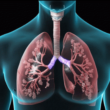COPD (Chronic Obstructive Pulmonary Disease)
Knowing About Chronic Obstructive Pulmonary Disease (COPD) Can Make Breathing Easier
The phrase “chronic obstructive pulmonary disease” (COPD) refers to a group of progressive lung disorders that impede breathing. Airflow restriction from COPD, which is sometimes mistaken for emphysema or chronic bronchitis, gets worse over time. Although there isn’t a treatment for COPD, being aware of it will help you manage it well and lead a happy life.
Table of Contents

Exposing the Causes: What Leads to COPD?
COPD (Chronic Obstructive Pulmonary Disease)
More than 70% of COPD cases are caused by smoking, making it the primary cause of the disease. Cigarette smoke contains harmful substances that cause gradual lung damage and blockage of airflow. Still, other offenders may also be involved:
- Secondhand Smoke: Being around secondhand smoke greatly raises your chance of developing COPD.
- Air pollution: Burning biomass fuels, industrial emissions, and prolonged exposure to traffic fumes irritate the lungs and cause COPD.
- Occupational Exposures: Breathing in chemicals, dust, or fumes while working in several occupations can harm your lungs and raise your chance of developing COPD.
- Genetics: Although not a direct cause, genetics can influence a person’s propensity to develop COPD.
The Quiet Robber: Early COPD Symptoms and Signs
COPD (Chronic Obstructive Pulmonary Disease)
Early signs of COPD might be readily misdiagnosed as a persistent cough or sporadic dyspnea. But when the illness worsens, these signs and symptoms intensify:
- Breathlessness: This is the most prevalent symptom and is most obvious when exercising.
- Chronic Cough: One of the main indicators of COPD is a chronic cough that frequently produces mucus (phlegm).
- Wheezing: Narrowed airways cause a whistling sound to be produced during breathing.
- Chest Tightness: Breathing problems may be accompanied by a tightness or pressure in the chest.
- Fatigue: The increased work needed to breathe due to COPD can make even routine tasks exhausting.
- Frequent Respiratory Infections: Colds, the flu, and pneumonia are more common in people with COPD.
You should see a doctor right away if you encounter any of these symptoms, particularly if you smoke or other risk factors. This will ensure a proper diagnosis and prompt treatment.
Exposing the Realities: How Is COPD Diagnosed?
COPD (Chronic Obstructive Pulmonary Disease)
COPD diagnosis usually requires a multifaceted approach:
- Medical History: Your symptoms, smoking history, and exposure to risk factors will all be questioned by the doctors.
- Physical examination: This involves evaluating your breathing patterns and listening to your lungs to detect wheezing.
- Spirometry: This lung function test gauges how quickly and how much air you can forcibly exhale.
- Chest X-ray: This can help rule out other lung problems but is not a conclusive diagnosis for COPD.
- Blood tests: These might be performed to rule out further reasons for dyspnea.
COPD (Chronic Obstructive Pulmonary Disease)
Early diagnosis improves quality of life and slows the progression of disease by enabling prompt treatment and care.
Taking Charge: COPD Treatment Options
COPD (Chronic Obstructive Pulmonary Disease)
Effective therapies can help control symptoms, enhance quality of life, and delay the progression of the disease, even though there is no known cure for COPD. The following are some crucial tactics:
- Quitting smoking: is the single most essential thing you can do to manage your COPD. Giving up smoking can greatly reduce symptoms and help stop additional lung damage.
- Bronchodilators: These drugs ease breathing by relaxing the muscles in the airways.
- Inhaled Steroids: Inhaled steroids have the potential to lessen inflammation and alleviate symptoms in certain individuals with COPD that has an inflammatory component.
- Pulmonary Rehabilitation: To assist individuals with COPD in managing their symptoms and continuing with everyday activities, this program combines education and exercise training.
- Oxygen Therapy: To raise blood oxygen levels and facilitate breathing, more oxygen may be required in situations of severe COPD.
Adhering to their treatment plan and implementing healthy lifestyle choices can significantly reduce symptoms and enable patients with COPD to lead active lives.
COPD (Chronic Obstructive Pulmonary Disease)
Note: This data offers a broad picture of COPD. Seeking individualised advice and treatment from a healthcare expert is advised.


